The Great Depression & WW II
War Begins
Even though Americans knew that war was getting close to American shores, most were still shocked when the Japanese attacked the U.S. naval base at Pearl Harbor on December 7, 1941.
It was early Sunday morning in Hawaii when Japanese planes started dropping bombs and torpedoes on U.S. ships. The American military was not prepared for an attack. The ships were lined up side by side where an explosion on one ship could cause damage to others.
Within a short time, five of eight battleships were sunk with the rest damaged. Most of the airplanes were destroyed on the ground. More than 2,400 Americans died.
During the attack, Nashvillian Cornelia Fort was flying above Hawaii, giving a flying lesson, when she looked up and saw Japanese planes coming straight at her plane.
"I jerked the controls away from my student and jammed the throttle wide open to pull above the oncoming planes," Fort described later. She landed her plane safely on the ground with bullets splattering around them.
Many Tennesseans heard about the attack on a radio news bulletin. Many felt surprise, fear, or anger at the news, and all knew that the attack meant war. No American alive that day ever forgot where they were when they heard about the attack on Pearl Harbor.
Listen to a radio broadcast news bulletin about Pearl Harbor on December 7, 1941.
http://tn4me.org/audio/pearlharbor-bulletin.mp3
The next day President Franklin Roosevelt addressed Congress and asked them to declare war on Japan. On December 11, 1941, Germany and Italy declared war on the United States, and Congress declared war on them.
Dig Deeper: Why did Roosevelt ask Congress for a war declaration?
Dig Deeper: Why did Roosevelt ask Congress for a war declaration?
Listen to Roosevelt’s speech to Congress on December 8, 1941.
http://tn4me.org/audio/FDR-12081941.mp3
To read more about Pearl Harbor, click here.
Picture Credits:
- An aerial view of Pearl Harbor after the Japanese attack began on December 7, 1941. The photograph was taken from a Japanese airplane and later in the war it was found by U.S. forces. The ships lined up in the front are on "Battleship Row" and are still intact. Of the eight battleships, five would be sunk. Apparently at least one ship, the USS West Virginia in the middle, has been hit as shown by the ripples and spreading oil slick beside it. The West Virginia would eventually burn and sink to the bottom with the loss of more than 100 lives. The smoke in the back of the photograph is from Japanese bombs dropped on Hickam air field. U.S. Naval Historical Center photograph
- USS Arizona has partially sunk and is still burning. Her forward magazine (compartment for holding explosives) exploded when it was hit by a Japanese bomb. The men in the small boat in front are looking for survivors in the water. National Archives
- A patrol airplane is burning after being hit by Japanese bombs while still on the ground at the Naval Air Station at Oahu, Hawaii. The seamen in front are attempting to control the flames by spraying the fire with water. Official U.S. Navy Photograph, now in the collections of the National Archives
- Nashvillian Cornelia Fort stands by her airplane in this photograph taken in 1942. She had become a pilot at the age of 21. After her close call at Pearl Harbor, Fort became a WAFS (Women's Auxiliary Ferrying Squadron) pilot. She flew newly completed bombers and other types of planes from the factories to different air fields in the U.S.
Fort died on March 1943 when another airplane hit hers while she was flying near Abilene, Texas. She was the first woman pilot to be killed in the line of duty. She was 24 years old. Special Collections Division of the Nashville Public Library
- President Franklin Roosevelt signs the declaration of war against Japan on December 8, 1941, the day after the Japanese attacked Pearl Harbor. He is wearing a black armband on his left arm to signify his mourning for the 2,400 Americans who had died during the attack. National Archives and Records Administration
The Great Depression & WW II >> World War II >> The Gathering Storm >> War Begins
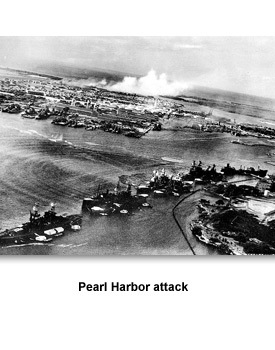
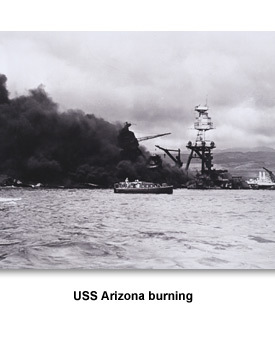
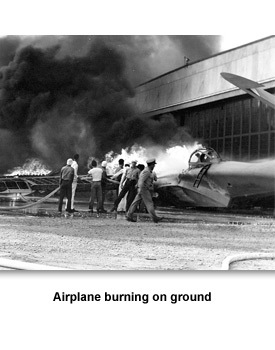
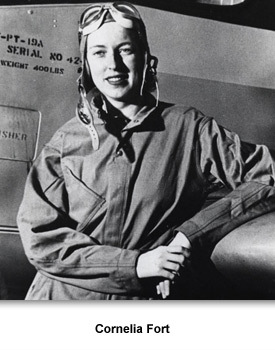
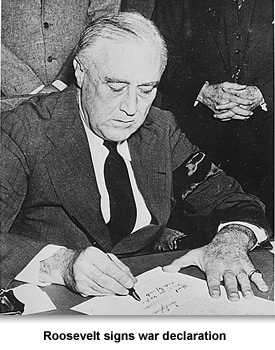
 Sponsored by: National Endowment for the Humanities
Sponsored by: National Endowment for the Humanities